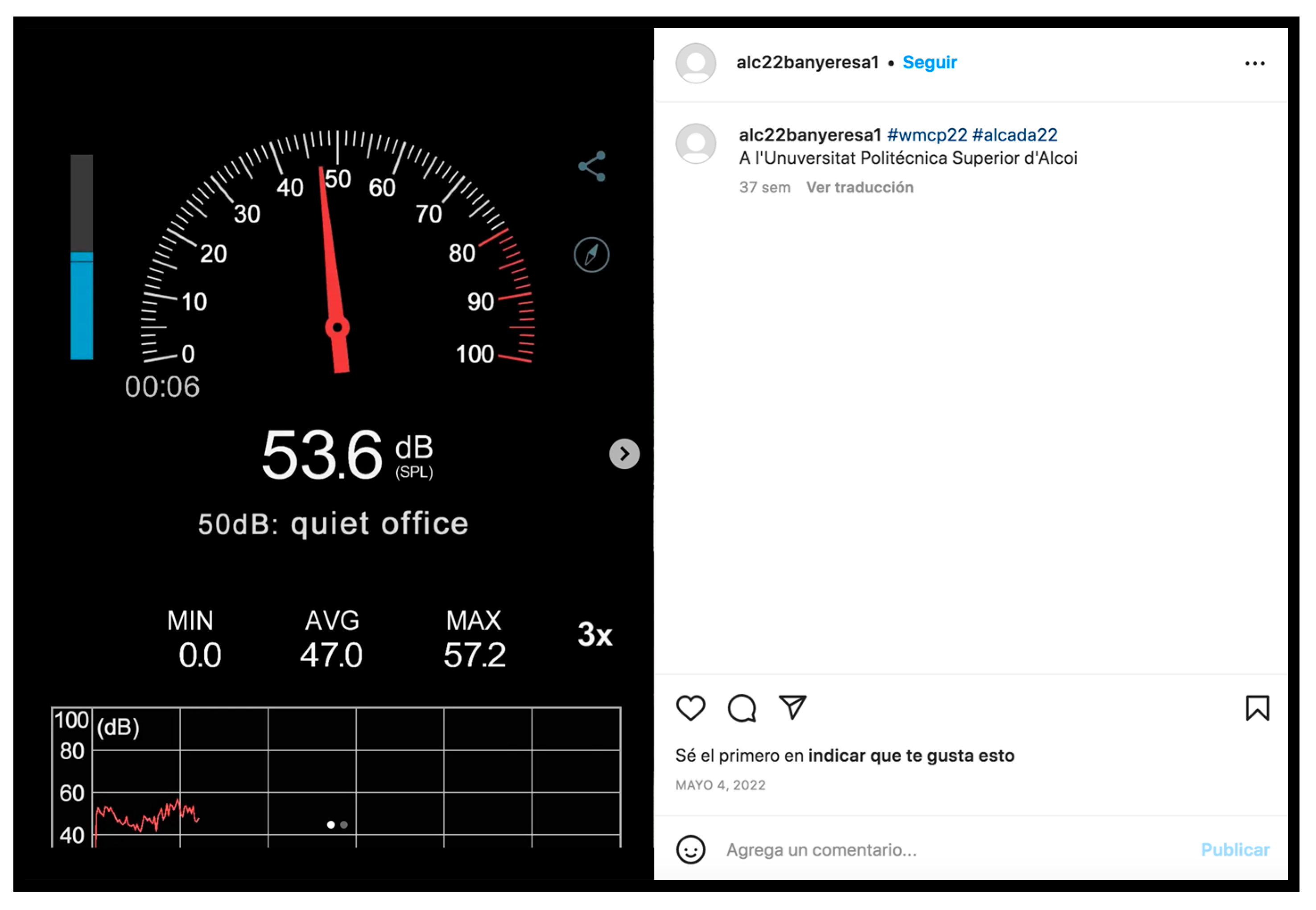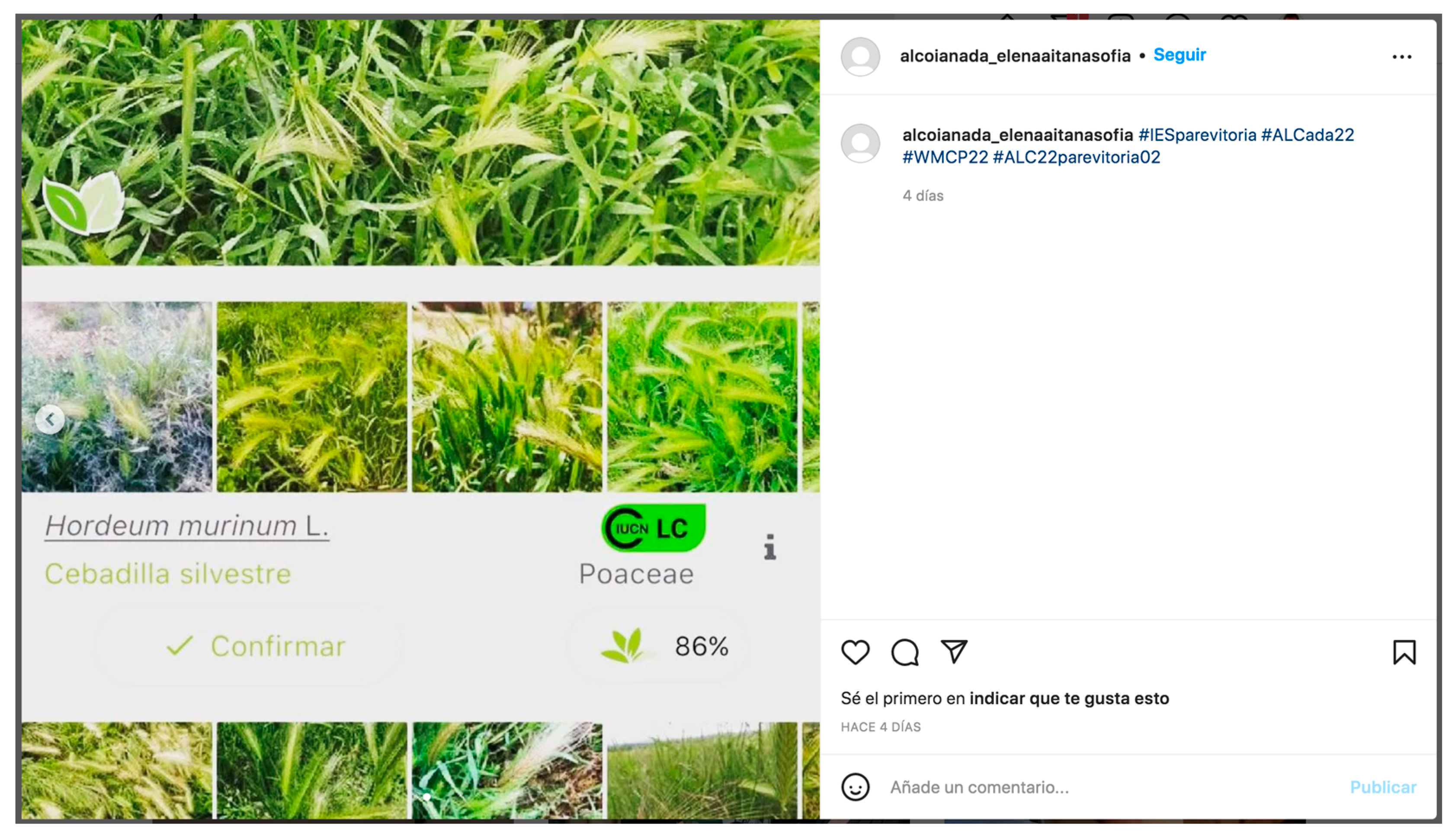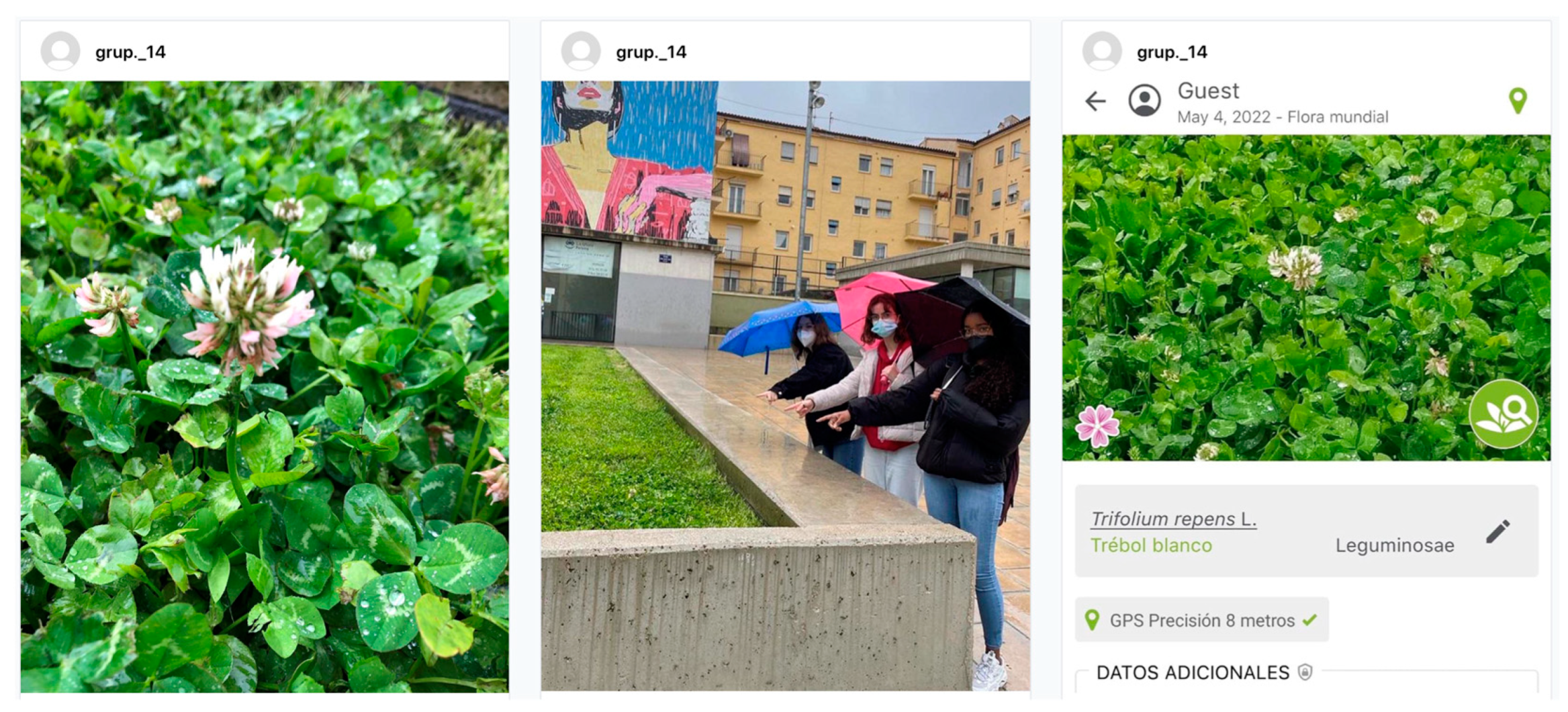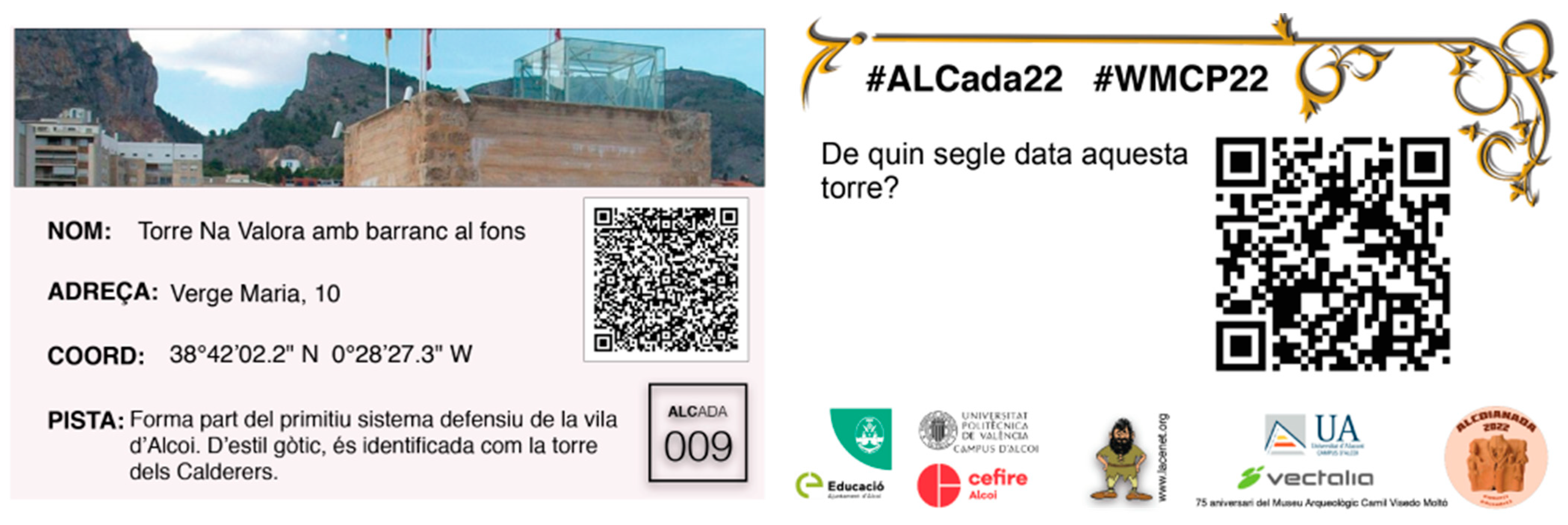Urban Itineraries with Smartphones to Promote an Improvement in Environmental Awareness among Secondary School Students
Abstract
1. Introduction
1.1. Environmental Education and Educational Technology
1.2. An Example of Activity to Promote Learning
- Get to know the most immediate urban environment for students;
- Know the culture, art, history, and the urban natural environment;
- Identify and deepen knowledge of points of interest in the city of Alcoy;
- Learn to find your way around the city, both on foot and by public transport;
- Develop digital competence, both in the use of mobile devices, in augmented reality and geolocation applications, in social networks, etc.;
- Live, socialize, and interact with the citizens of Alcoy;
- Work collaboratively with group members;
- Relate and interact with students of the same age and from other educational centers.
- Identify the trees around them by using an augmented reality application installed on their mobiles;
- Recognize and measure the noise pollution present in the city through the use of a mobile application that allows you to measure the sound decibels that occur in a specific place.
1.3. Objectives
- -
- Check the acceptance of activities to promote environmental awareness in an urban environment among secondary school students.
- -
- Additionally, as specific objectives, it is also sought:
- Check if there are differences between the interests of men and women around activities of an environmental nature;
- Check if this type of activity generates interest and motivation to learn and, more specifically, due to the environmental problems of our cities.
2. Materials and Methods
- Prior to the activity,
- The activity or gymkhana (team competition game in which the participants must overcome a series of tests that can be of ingenuity, ability, physical, or sports along a route),
- After the activity.
2.1. Activity
2.2. Data Collection Instruments
2.3. Participants
3. Results
3.1. Overall Results
3.2. Results According to the Different Variables
3.3. Qualitative Results
- Live outside the classroom with other students (n = 76),
- Learn interesting things about my city (n = 53),
- Learn to use public transport (n = 41),
- Know and identify the trees and plants of my city (n = 32),
- Identify those areas of my city with the highest noise pollution (n = 27).
“What I liked the most was being able to learn in a fun way, outside the center, to identify plants and trees in my city, as well as to measure the levels of noise pollution that we find in the streets.”—ST061
“I really liked the tests, especially those in which we had to use mobile applications to identify trees and measure the noise of cars and motorcycles.”—ST124
4. Discussion
5. Conclusions
Funding
Institutional Review Board Statement
Informed Consent Statement
Data Availability Statement
Acknowledgments
Conflicts of Interest
Appendix A


Appendix B


Appendix C
- Your center: * (Mark only one).
- La Salle
- Esclaves SCJ Alcoi
- IES Andreu Sempere
- IES Pare Vitoria
- C. Sant Vicent de Paul
- C. Santa Ana
- IES Cotes Baixes
- IES Serra Mariola—Muro d’Alcoi
- IES Prof. Manuel Broseta—Bañeres de Mariola
- Gender: * (Mark only one).
- woman
- man
- not binary
- Age: *
- 4.
- Rate the activity: ALCada22 (from 1: I didn’t like it at all, to 5: I liked it/ liked very much) *
- 1
- 2
- 3
- 4
- 5
- 5.
- To what extent would you say that your level of awareness and concern about the environmental problems we suffer has improved? (from 1: not at all or very little to 5: a lot or a lot)*.
- 1
- 2
- 3
- 4
- 5
- 6.
- Mark only one oval per row.
Test 1 2 3 4 5 6 F01 registration of pollution acoustic with Sound meter F02 identify trees/plants with PlantNet F03 bookface V01 popular dance of Moros and Cristianos V02 video interview to one citizen of how it was the school before V03 reciting verses in Valencian - 7.
- Evaluate ALCada22 in words and in a global way *.
- 8.
- What did you like least? (Expose which thing(s) you would change about to upcoming editions of the activity) *.
- 9.
- Say what you liked mst about the activity (Do you think it generates interest and motivation to learn? Improves learning? Educates in the environment? Develops your digital skills? Improves group work? etc.) *.
References
- Kroll, C.; Warchold, A.; Pradhan, P. Sustainable Development Goals (SDGs): Are we successful in turning trade-offs into synergies? Palgrave Commun. 2019, 5, 140. [Google Scholar] [CrossRef]
- Herremans, I.M.; Reid, R.E. Developing Awareness of the Sustainability Concept. J. Environ. Educ. 2002, 34, 16–20. [Google Scholar] [CrossRef]
- McFarlane, D.A.; Ogazon, A.G. The challenges of sustainability education. J. Multidiscip. Res. 2011, 3, 81–107. [Google Scholar]
- Novo, M. La educación ambiental, una genuina educación para el desarrollo sostenible. Rev. De Educ. 2009, 195–217. Available online: http://hdl.handle.net/11162/74555 (accessed on 20 November 2022).
- Márquez Delgado, D.L.; Hernández Santoyo, A.; Márquez Delgado, L.H.; Casas Vilardell, M. La educación ambiental: Evolución conceptual y metodológica hacia los objetivos del desarrollo sostenible. Rev. Univ. Y Soc. 2021, 13, 301–310. [Google Scholar]
- Hernández-Castilla, R.; Slater, C.; Martínez-Recio, J. Los objetivos de Desarrollo Sostenible, un reto para la escuela y el liderazgo escolar. Profr. Rev. De Currículum Y Form. Del Profr. 2020, 24, 9–26. [Google Scholar] [CrossRef]
- Mora Zapater, J.L. La Educación Ambiental como catalizador del desarrollo sostenible en la educación superior 2015–2020. Revisión Sistemática. Crescendo 2021, 11, 443–462. [Google Scholar] [CrossRef]
- Alonso-Sainz, T. Educación para el desarrollo sostenible: Una visión crítica desde la Pedagogía. Rev. Complut. De Educ. 2021, 32, 249–259. [Google Scholar] [CrossRef]
- Aguirregabiria Barturenn, F.J.; García Olalla, A.M. Aprendizaje basado en proyectos y desarrollo sostenible en el Grado de Educación Primaria. Enseñanza De Las Cienc. 2020, 38, 5–24. [Google Scholar] [CrossRef]
- Benayas del Álamo, J.; Mercén Albero, C. Hacia una Educación para la Sostenibilidad. 20 años después del Libro Blanco de la Educación Ambiental en España. Informe 2019; Centro Nacional de Educación Ambiental (CENEAM), Organismo Autónomo Parques Nacionales, Ministerio para la Transición Ecológica: Madrid, Spain, 2019. [Google Scholar]
- Montero Caro, M.D. Educación, Gobierno Abierto Y Progreso: Los Objetivos De Desarrollo Sostenible (ODS) En El ámbito Educativo. Una visión crítica De La LOMLOE. Rev. De Educ. Y Derecho 2021, 23, 1–26. [Google Scholar] [CrossRef]
- García Ferrandis, X.; García Ferrandis, I.; García Gómez, J. Los efectos de la contaminación acústica en la salud: Conceptualizaciones del alumnado de Enseñanza Secundaria Obligatoria de Valencia. Didáctica De Las Cienc. Exp. Y Soc. 2010, 24, 123–137. [Google Scholar]
- Lagonigro, R.; Martori, J.C.; Apparicio, P. Environmental noise inequity in the city of Barcelona. Transp. Res. Part D Transp. Environ. 2018, 63, 309–319. [Google Scholar] [CrossRef]
- Maisonneuve, N.; Stevens, M.; Niessen, M.E.; Hanappe, P.; Steels, L. Citizen noise pollution monitoring. In Proceedings of the 10th International Digital Government Research Conference, Puebla, Mexico, 17–20 May 2009; pp. 96–103. Available online: http://hdl.handle.net/10261/127898 (accessed on 20 November 2022).
- Maisonneuve, N.; Stevens, M.; Niessen, M.E.; Steels, L. NoiseTube: Measuring and mapping noise pollution with mobile phones. In Information Technologies in Environmental Engineering. Environmental Science and Engineering; Athanasiadis, I.N., Rizzoli, A.E., Mitkas, P.A., Gómez, J.M., Eds.; Springer: Berlin/Heidelberg, Germany, 2009. [Google Scholar] [CrossRef]
- Zannin, P.H.T.; Ferreira, A.M.C.; Szeremetta, B. Evaluation of noise pollution in urban parks. Environ. Monit. Assess. 2006, 118, 423–433. [Google Scholar] [CrossRef] [PubMed]
- Dzhambov, A.M.; Dimitrova, D.D. Urban green spaces’ effectiveness as a psychological buffer for the negative health impact of noise pollution: A systematic review. Noise Health 2014, 16, 157–165. [Google Scholar] [CrossRef]
- Barnett, M.; Vaughn, M.H.; Strauss, E.; Cotter, L. Urban environmental education: Leveraging technology and ecology to engage students in studying the environment. Int. Res. Geogr. Environ. Educ. 2011, 20, 199–214. [Google Scholar] [CrossRef]
- Echeverria, A.; Ariz, I.; Moreno, J.; Peralta, J.; Gonzalez, E.M. Learning Plant Biodiversity in Nature: The Use of the Citizen–Science Platform iNaturalist as a Collaborative Tool in Secondary Education. Sustainability 2021, 13, 735. [Google Scholar] [CrossRef]
- Van Haeften, S.; Milic, A.; Addison-Smith, B.; Butcher, C.; Davies, J.M. Grass Gazers: Using citizen science as a tool to facilitate practical and online science learning for secondary school students during the COVID-19 lockdown. Ecol. Evol. 2021, 11, 3488–3500. [Google Scholar] [CrossRef]
- Palumbo, M.J.; Johnson, S.A.; Mundim, F.M.; Lau, A.; Wolf, A.C.; Arunachalam, S.; Gonzalez, O.; Ulrich, J.L.; Washuta, A.; Bruna, E.M. Harnessing Smartphones for Ecological Education, Research, and Outreach. Bull. Ecol. Soc. Am. 2012, 93, 390–393. [Google Scholar] [CrossRef]
- Merma-Molina, G.; Gavilán-Martín, D.; Álvarez-Herrero, J.F. Education for Sustainable Development: The Impact of the Values in Mobile Phone Addiction. Sustainability 2021, 13, 1479. [Google Scholar] [CrossRef]
- IAB Spain. Estudio de Redes Sociales 2022. Elogia. Available online: https://iabspain.es/estudio/estudio-de-redes-sociales-2022/ (accessed on 20 October 2022).
- Wavemaker. Informe sobre los adolescentes. GroupM LIVE Panel. Available online: https://wavemakerglobal.com/es/wp-content/uploads/sites/12/2021/04/LIVE-Panel-Teenagers.pdf (accessed on 20 October 2022).
- Zachos, G.; Paraskevopoulou-Kollia, E.A.; Anagnostopoulos, I. Social Media Use in Higher Education: A Review. Educ. Sci. 2018, 8, 194. [Google Scholar] [CrossRef]
- Lytras, M.D.; Visvizi, A.; Daniela, L.; Sarirete, A.; Ordonez De Pablos, P. Social Networks Research for Sustainable Smart Education. Sustainability 2018, 10, 2974. [Google Scholar] [CrossRef]
- Toda, A.M.; do Carmo, R.M.; da Silva, A.P.; Bittencourt, I.I.; Isotani, S. An approach for planning and deploying gamification concepts with social networks within educational contexts. Int. J. Inf. Manag. 2019, 46, 294–303. [Google Scholar] [CrossRef]
- Tomczyk, Ł.; Costas Jáuregui, V.; Albuquerque de La Higuera Amato, C.A.; Muñoz, D.; Arteaga, M.; Sunday Oyelere, S.; Akyar, Ö.Y.; Porta, M. Are teachers techno-optimists or techno-pessimists? A pilot comparative among teachers in Bolivia, Brazil, the Dominican Republic, Ecuador, Finland, Poland, Turkey, and Uruguay. Educ. Inf. Technol. 2021, 26, 2715–2741. [Google Scholar] [CrossRef] [PubMed]
- Ariel, Y.; Elishar-Malka, V. Learning in the smartphone era: Viewpoints and perceptions on both sides of the lectern. Educ. Inf. Technol. 2019, 24, 2329–2340. [Google Scholar] [CrossRef]
- Elisa, E.; Farhan, A.; Herliana, F.; Wahyuni, A.; Susanna, S. High school Physics teachers’ perceptions of the learning revolution era 4.0 at training activities in Bener Meriah Regency. J. Phys. Conf. Ser. 2021, 1882, 012030. [Google Scholar] [CrossRef]
- Nami, F. Educational smartphone apps for language learning in higher education: Students’ choices and perceptions. Australas. J. Educ. Technol. 2020, 36, 82–95. [Google Scholar] [CrossRef]
- Hochberg, K.; Kuhn, J.; Müller, A. Using Smartphones as Experimental Tools—Effects on Interest, Curiosity, and Learning in Physics Education. J. Sci. Educ. Technol. 2018, 27, 385–403. [Google Scholar] [CrossRef]
- Klimova, B. Impact of Mobile Learning on Students’ Achievement Results. Educ. Sci. 2019, 9, 90. [Google Scholar] [CrossRef]
- Hartley, K.; Andújar, A. Smartphones and Learning: An Extension of M-Learning or a Distinct Area of Inquiry. Educ. Sci. 2022, 12, 50. [Google Scholar] [CrossRef]
- Álvarez-Herrero, J.F.; Hernández-Ortega, J. Itinerarios didácticos con smartphones para promover la educación ambiental y la competencia digital entre el alumnado de secundaria. Digit. Educ. Rev. 2021, 39, 319–335. [Google Scholar] [CrossRef]
- Álvarez Suarez, P.; Vega Marcote, P. Developing sustainable environmental behavior in secondary education students (12–16) Analysis of a didactic strategy. Procedia-Soc. Behav. Sci. 2010, 2, 3568–3574. [Google Scholar] [CrossRef]
- García-González, E.; Jiménez-Fontana, R.; Goded, P.A. Approaches to teaching and learning for sustainability: Characterizing students’ perceptions. J. Clean. Prod. 2020, 274, 122928. [Google Scholar] [CrossRef]
- Taylor, N.; Quinn, F.; Jenkins, K.; Miller-Brown, H.; Rizk, N.; Prodromou, T.; Serow, P.; Taylor, S. Education for Sustainability in the Secondary Sector—A Review. J. Educ. Sustain. Dev. 2019, 13, 102–122. [Google Scholar] [CrossRef]
- Barlam Aspachs, R.; Ribas Soler, M.; Foixenc Pérez, N.; Rochera Villach, M.J. Dispositivos móviles y personalización del aprendizaje. La Manresada, mi Manresada. In Dosier Graó nº 3: La Personalización del Aprendizaje; Coll, C., Ed.; Graó: Barcelona, Spain, 2018. [Google Scholar]
- Riola Devant, C.; Pelegrina Romera, J.; Biescas Chic, L.; Barlam Aspachs, R. Barcelonada’13: Una yincana con dispositivos móviles. Cuad. De Pedagog. 2014, 442, 41–46. [Google Scholar]
- Varona Klioukina, S.; Villablanca Retamal, A. La Barcelonada 2019: Análisis de una práctica educativa que utiliza las TIC para promover la conexión entre contextos de aprendizaje y los intereses del alumnado. In Educació 2019: Reptes, Tendències i Compromisos: Llibre d’actes: I Conferència Internacional de Recerca en Educació; Lindín, C., Esteban, M.B., Bergmann, J.C.F., Castells, N., Rivera-Vargas, P., Eds.; Liberlibro: Albacete, Spain, 2020; pp. 547–555. [Google Scholar]
- Álvarez-Herrero, J.F. Aprendizaje móvil con itinerarios didácticos en alumnado de secundaria con geolocalización, realidad aumentada e Instagram. In Claves Para la Innovación Pedagógica Ante los Nuevos Retos: Respuestas en la Vanguardia de la Práctica Educativa; Cobos-Sanchiz, D., López-Meneses, E., Molina-García, L., Jaén-Martínez, A., Martín-Padilla, A.H., Eds.; Octaedro: Barcelona, Spain, 2020; pp. 1140–1148. [Google Scholar]
- Álvarez-Herrero, J.F. Aprendizaje móvil fuera del aula en Educación Secundaria. In Experiencias Pedagógicas e Innovación Educativa. Aportaciones Desde la Praxis Docente e Investigadora; López-Meneses, E., Cobos-Sanchiz, D., Martín-Padilla, A.H., Molina-García, L., Jaén-Martínez, A., Eds.; Octaedro: Barcelona, Spain, 2018; pp. 937–943. [Google Scholar]
- López de Haro, F.; Segura Serrano, J.A. Los itinerarios didácticos: Un recurso interdisciplinar y vertebrador del currículum. Espiral. Cuad. Del Profr. 2013, 6, 15–31. [Google Scholar] [CrossRef]
- Maccagno, A.P. Itinerarios interactivos con realidad aumentada en procesos de evaluación. Reflexión Académica En Diseño Y Comun. 2020, 43, 228–235. [Google Scholar]
- Montero Pozo, J.; Jerez García, O. The teaching itinerary as a resource for development of communication competences: Design of a bilingual app. In La Competencia Lingüística en la Comunicación: Visiones Multidisciplinares y Transversalidad; Salido López, J.V., Salido López, P.V., Eds.; Ediciones de la Universidad de Castilla-La Mancha: Cuenca, Spain, 2019; pp. 199–207. [Google Scholar] [CrossRef]
- Torralba Burrial, A.; Herrero Vázquez, M. El aprendizaje móvil (mlearning) aplicado a la Didáctica del Medio Natural en la formación inicial de Maestros en Educación Primaria y en Educación Infantil. In EDUNOVATIC 2016, I Congreso Virtual Internacional sobre Educación, Innovación y TIC; REDINE: Madrid, Spain, 2016; pp. 502–507. [Google Scholar]
- Lee, J.; Shepley, M.M. College Campuses and Student Walkability: Assessing the Impact of Smartphone Use on Student Perception and Evaluation of Urban Campus Routes. Sustainability 2020, 12, 9986. [Google Scholar] [CrossRef]
- Alcántara Manzanares, J.; Medina Quintana, S. El uso de los itinerarios didácticos (SIG) en la educación ambiental. Enseñanza De Las Cienc. 2019, 37, 173–188. [Google Scholar] [CrossRef]
- Álvarez-Herrero, J.F. Aprendizaje móvil con geolocalización y Realidad Aumentada en la realización de itinerarios didácticos. In EDUcación y TECnología. Propuestas Desde la Investigación y la Innovación Educativa; Roig-Vila, R., Ed.; Octaedro: Barcelona, Spain, 2016; pp. 13–14. [Google Scholar]
- Cheng, S.C.; Hwang, G.J.; Chen, C.H. From reflective observation to active learning: A mobile experiential learning approach for environmental science education. Br. J. Educ. Technol. 2019, 50, 2251–2270. [Google Scholar] [CrossRef]
- Martín Hernanz, S. Propuesta metodológica para el diseño de itinerarios didácticos de Ciencias de la Naturaleza. Didácticas Específicas 2016, 14, 144–150. [Google Scholar]
- San Pedro Veledo, M.B.; López Manrique, I.; Fombella Coto, I.; Del Cura González, Y.; Sánchez Martínez, B.; Álvarez González, A.I. Social Sciences, Art and Physical Activity in Leisure Environments. An Inter-Disciplinary Project for Teacher Training. Sustainability 2018, 10, 1786. [Google Scholar] [CrossRef]
- Väljataga, T.; Mettis, K. Secondary Education Students’ Knowledge Gain and Scaffolding Needs in Mobile Outdoor Learning Settings. Sustainability 2022, 14, 7031. [Google Scholar] [CrossRef]
- Cassany, D. En_Línea: Leer y Escribir en la Red; Anagrama: Madrid, Spain, 2012. [Google Scholar]
- Sáez-Bondía, M.J.; Cortés-Gracia, A.L. ¿Cómo cambian las ideas de los estudiantes de Máster de Profesorado sobre una actividad práctica de campo tras su vídeo-análisis y discusión en pequeños grupos? Rev. Eureka Sobre Enseñanza Y Divulg. De Las Cienc. 2019, 16, 2602. [Google Scholar] [CrossRef]
- Valverde-Crespo, D.; de Pro-Bueno, A.; González-Sánchez, J. La competencia informacional-digital en la enseñanza y aprendizaje de las ciencias en la educación secundaria obligatoria actual: Una revisión teórica. Rev. Eureka Sobre Enseñanza Y Divulg. De Las Cienc. 2018, 15, 2105. [Google Scholar] [CrossRef]
- Buchanan, J.; Pressick-Kilborn, K.; Maher, D. Promoting Environmental Education for Primary School-aged Students Using Digital Technologies. Eurasia J. Math. Sci. Technol. Educ. 2019, 15, em1661. [Google Scholar] [CrossRef]
- Ayerbe López, J.; Perales Palacios, F.J. Reinventa tu ciudad: Aprendizaje basado en proyectos para la mejora de la conciencia ambiental en estudiantes de Secundaria. Enseñanza De Las Cienc. 2020, 38, 181–203. [Google Scholar] [CrossRef]

| Test | |
|---|---|
| F01 | Take a screenshot with the highest record you get with the app: Sound meter at the point of interest you had to visit. Upload it as an image to Instagram and write in the comment the exact geolocation of the photo, putting the name of the place with the noise pollution record obtained. (Examples of this test can be seen in the Appendix A). |
| F02 | Take a group photo with a nearby plant and upload it to Instagram, writing the common and scientific name of the species, using the app: PlantNet that allows you to identify trees, plants, or shrubs present at a point close to the point of interest that you had to visit (optional label: #ciutatverda). (Examples of this test can be seen in the Appendix B). |
| F03 | Take a BookFace photo (You must take a photo integrating a book, body, and environment and upload it to Instagram). Try to be original. (optional tag: #BookFace) |
| V01 | Do a dance, choreography, dance of Moros and Cristianos, etc. With or without costumes, with or without music. Make use of your imagination. |
| V02 | Do a short video-interview with someone who passes by the point of interest you are visiting in which you ask that person: what was school like when they were a student? |
| V03 | Make a video in which you are reciting verses in Valencian, by a well-known author or created by you. |
| Center | Activity | |
|---|---|---|
| Students | Teachers | |
| C01 | 35 | 3 |
| C02 | 52 | 5 |
| C03 | 35 | 3 |
| C04 | 45 | 3 |
| C05 | 23 | 1 |
| C06 | 32 | 2 |
| C07 | 30 | 2 |
| C08 | 35 | 3 |
| C09 | 24 | 2 |
| Total | 311 | 24 |
| Center | Activity | Questionnaire | Percentage of Participation in the Evaluation Questionnaire | ||
|---|---|---|---|---|---|
| Frequency | Percentage | Frequency | Percentage | ||
| C01 | 35 | 11.3 | 17 | 8.0 | 48.6 |
| C02 | 52 | 16.7 | 45 | 21.0 | 86.5 |
| C03 | 35 | 11.3 | 27 | 12.6 | 77.1 |
| C04 | 45 | 14.4 | 40 | 18.7 | 88.9 |
| C05 | 23 | 7.4 | 16 | 7.5 | 69.5 |
| C06 | 32 | 10.3 | 26 | 12.1 | 81.2 |
| C07 | 30 | 9.6 | 10 | 4.7 | 33.3 |
| C08 | 35 | 11.3 | 9 | 4.2 | 25.7 |
| C09 | 24 | 7.7 | 24 | 11.2 | 100 |
| Total | 311 | 100 | 214 | 100 | 68.8 |
| F01 | F02 | F03 | V01 | V02 | V03 | |
|---|---|---|---|---|---|---|
| Average | 3.12 | 3.06 | 3.25 | 3.26 | 3.12 | 2.78 |
| Standard deviation | 1.271 | 1.297 | 1.256 | 1.258 | 1.286 | 1.266 |
| Variance | 1.615 | 1.682 | 1.577 | 1.582 | 1.653 | 1.602 |
| Activity | F01 | F02 | F03 | V01 | V02 | V03 | |
|---|---|---|---|---|---|---|---|
| Men | 3.39 | 3.35 | 3.33 | 3.25 | 3.10 | 3.00 | 2.87 |
| Women | 3.43 | 2.98 | 2.91 | 3.35 | 3.48 | 3.34 | 2.77 |
| Non-binary | 1.75 | 2.13 | 1.88 | 1.88 | 2.00 | 1.50 | 1.63 |
| Global | 3.35 | 3.12 | 3.06 | 3.25 | 3.26 | 3.12 | 2.78 |
| Years | Activity | F01 | F02 | F03 | V01 | V02 | V03 |
|---|---|---|---|---|---|---|---|
| 14 | 3.70 | 3.27 | 3.32 | 3.54 | 3.68 | 3.59 | 3.00 |
| 15 | 3.51 | 3.44 | 3.44 | 3.60 | 3.35 | 3.20 | 2.82 |
| 16 | 2.99 | 2.70 | 2.60 | 2.76 | 2.88 | 2.75 | 2.48 |
| 17 | 3.19 | 2.81 | 2.48 | 2.81 | 3.33 | 3.10 | 3.14 |
| Global | 3.35 | 3.12 | 3.06 | 3.25 | 3.26 | 3.12 | 2.78 |
Disclaimer/Publisher’s Note: The statements, opinions and data contained in all publications are solely those of the individual author(s) and contributor(s) and not of MDPI and/or the editor(s). MDPI and/or the editor(s) disclaim responsibility for any injury to people or property resulting from any ideas, methods, instructions or products referred to in the content. |
© 2023 by the author. Licensee MDPI, Basel, Switzerland. This article is an open access article distributed under the terms and conditions of the Creative Commons Attribution (CC BY) license (https://creativecommons.org/licenses/by/4.0/).
Share and Cite
Álvarez-Herrero, J.-F. Urban Itineraries with Smartphones to Promote an Improvement in Environmental Awareness among Secondary School Students. Int. J. Environ. Res. Public Health 2023, 20, 2009. https://doi.org/10.3390/ijerph20032009
Álvarez-Herrero J-F. Urban Itineraries with Smartphones to Promote an Improvement in Environmental Awareness among Secondary School Students. International Journal of Environmental Research and Public Health. 2023; 20(3):2009. https://doi.org/10.3390/ijerph20032009
Chicago/Turabian StyleÁlvarez-Herrero, Juan-Francisco. 2023. "Urban Itineraries with Smartphones to Promote an Improvement in Environmental Awareness among Secondary School Students" International Journal of Environmental Research and Public Health 20, no. 3: 2009. https://doi.org/10.3390/ijerph20032009
APA StyleÁlvarez-Herrero, J.-F. (2023). Urban Itineraries with Smartphones to Promote an Improvement in Environmental Awareness among Secondary School Students. International Journal of Environmental Research and Public Health, 20(3), 2009. https://doi.org/10.3390/ijerph20032009






